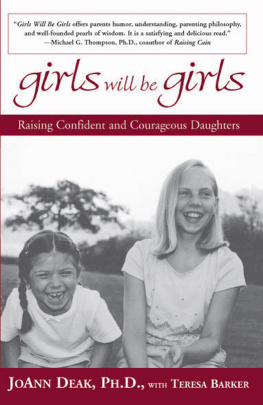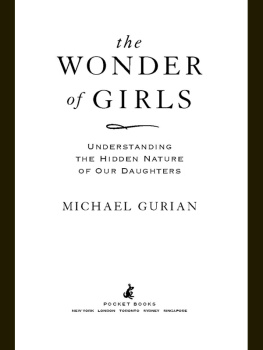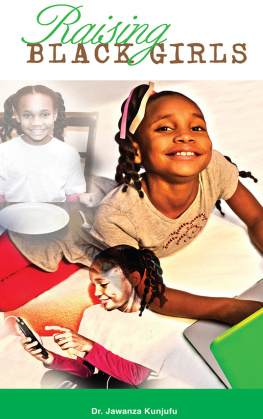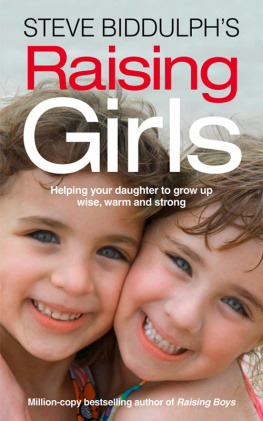Packaging Girlhood
Packaging Girlhood
RESCUING OUR DAUGHTERS FROM MARKETERS SCHEMES
Sharon Lamb, Ed.D., and Lyn Mikel Brown, Ed.D.
ST. MARTINS PRESS  NEW YORK
NEW YORK
PACKAGING GIRLHOOD. Copyright 2006 by Sharon Lamb, Ed.D., and Lyn Mikel Brown, Ed.D. All rights reserved. Printed in the United States of America. No part of this book may be used or reproduced in any manner whatsoever without written permission except in the case of brief quotations embodied in critical articles or reviews. For information, address
St. Martins Press, 175 Fifth Avenue, New York, N.Y. 10010.
Book design by Gretchen Achilles
www.stmartins.com
Library of Congress Cataloging-in-Publication Data
Lamb, Sharon.
Packaging girlhood : rescuing our daughters from marketers schemes / Sharon Lamb and Lyn Mikel Brown.1st ed.
p. cm.
ISBN-13: 978-0-312-35250-9
ISBN-10: 0-312-35250-6
1. Childrens paraphernaliaMarketingSocial aspectsUnited States. 2. GirlsUnited StatesSocial conditions21st century. 3. Child consumersUnited States. I. Brown, Lyn Mikel, 1956 II. Title.
HD9970.5.C483U655 2006
306.3dc22
2006002304
FIRST EDITION: August 2006
10 9 8 7 6 5 4 3 2 1
To our students, who inspire and teach us,
and to our families for their love and support
Preface
We wrote this book not as academics but as women, moms, and teachers living in a world of reality TV, instant messaging, and preteen lingerie. We teach about girls and womens development in our day jobs, and weve both written books about girls. We are considered experts and are called by journalists when they want a comment about a recent incident involving a girl or a new trend. We didnt take on this project as experts, though, but as consumers of a culture we share and sometimes dont share with girlsculture as presented in stores such as Victorias Secret and Hot Topic; kid cartoons such as Kim Possible and SpongeBob SquarePants; Mean Girl and Princess movies; magazines from Teen Voices to Teen People; books from Newbery winners to Gossip Girls; reality shows such as Americas Next Top Model and The Bachelorette; and all the other things that capture girls imaginations, time, and energy in the new millennium.
Weve been told our world empowers girls by offering them anything they want, including infinite sights and endless ports of call. In reality, its a world designed by media and marketing executives that targets children as consumers, channels girls desires, and entices them into predictable types: pretty pink dolls, cute little shoppers, and hott teens.
We did research to find out what girls are listening to, reading, and watching so that we could make sense of girl culture and think about what it means to our daughters and to us as parents and as muses to the next generation of girls. Beyond our own research we drew from the insights of scholars and popular culture gurus who have analyzed such products as magazines and lyrics, as well as from psychologists who have measured the influence of TV on the development of children, and more. What we would like to convey is something less particular and more systemic: a way of looking at the world that is both simple and revolutionary, a habit of seeing. We believe that parents can do what weve done without any particular training: They can analyze what their daughter sees, hears, wears, and reads in terms of how girlhood is packaged and sold to her.
This may sound like a cynical way to view the world, but once you see the insidious patterns and techniques of the media and marketers, you, too, will be suspicious. Just as you now read the nutrition content on the side of a cereal box before buying it for your child, you will be able to read the messages in the shows she watches, the stores she walks into, and the activities she engages in. It is our hope that moms and dads will be able to present the world to their daughters in such a way that she will have real choices in the world.
Researchers and educators in the 1970s began some important work when they analyzed how girls were represented in math story problems; they found that girls were less represented than boys and were shown doing traditionally feminine tasks such as cooking and sewing. These researchers and educators published studies which showed that both girls and boys pictured scientists as men in white lab coats; that few storybooks had female protagonists; and that to young children male pronouns are not gender neutral at all. They showed us that gender unfairness in school classrooms can be revealed by simply counting who gets called on and what kinds of feedback they receive from teachers. We all benefited from this foundational work that uncovered basic unfairness and its effects on children.
In todays world, where more young women than young men are going to college, where girls have opportunities to do so much more than ever before, the issue is not a simple one of who gets more or less. There are more women now on prime-time TV, but when they are competing in hot tubs for the attention of one man or undergoing radical surgery to compete in a beauty contest, we can see that simply being on TV isnt enough. The problem is one of image. What choices, what ways of being a girl are offered to our girls as they make their way in the world? We must look beyond the numbers at the kinds of girls presented and created as models for all girls. In our so-called girl power world, we can get fooled into thinking there is equity, but its more complicated than counting up how many girls are on cereal boxes. If you do that counting (we did), you will find many more boys than girls. Depending on the TV season, you may find no leading girls or girl characters on the covers of these boxes. Turn them around, look on the backs, and zero in on the gender of the cartoon characters. You will also see that girls are wearing the bows and barrettes, and boys are wearing the binoculars; that girls are passengers, and boys are drivers; that girls are batting long eyelashes, and boys are batting baseballs.
We encourage parents to look beyond the particulars and start to see the big picture. Examine that cute pink purse attached to the brand-name jeans and see that same little purse and jeans on a popular doll, in a popular movie, in a popular magazine; see it talked about in a popular book series and worn by a popular artist on a popular Web site and on a popular books cover. You will begin to appreciate the impact of marketing on your daughter. Her choice to buy that purse suddenly doesnt seem so free. Parents who look further and see that all the new jeans have little pink purses and make the connection to those other messages that encourage young girls to see themselves as hott, cute little shoppers will appreciate the larger intent of marketers and understand that what first appears as a lot of disconnected items actually amounts to a hard sell and big money for companiesat your daughters expense. Once your eyes have been opened, you might start looking for patterns and analyzing everything that has gone through the hands of marketers and the media. And once you start doing that, there is no going back. Youve lost the mindless innocence that marketers hope you have. You will be harder to fool and a harder sell. Most important, youll see that every new package a marketer creates is more of the same and hardly new at all. Score one for the parents and one for the daughters, too, because parents can help girls see what theyre being sold about themselves.
Our focus is not just on the manipulation, however. There are wonderful books that warn parents about the cheesy and deceitful ways that marketers target our children. We also look at the message theyre selling through their practice, a message about normal girlhood packaged in the form of that little pink purse, the sexy performer who wears it, the tight low-rider jeans it is attached to, and the pouty hot boy it is supposed to attract. The little purse connects girlhood with shopping, yes, but mostly it defines a










 NEW YORK
NEW YORK